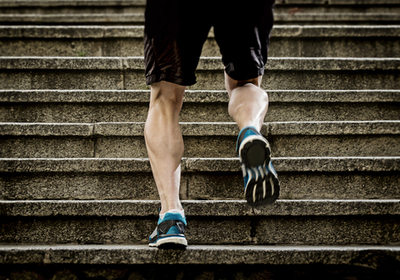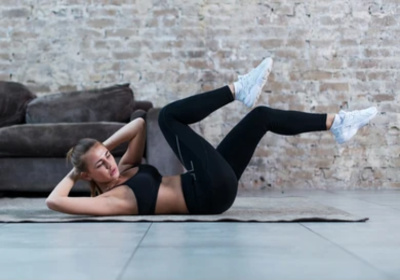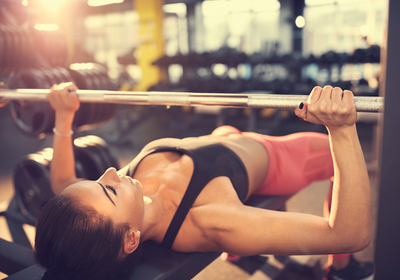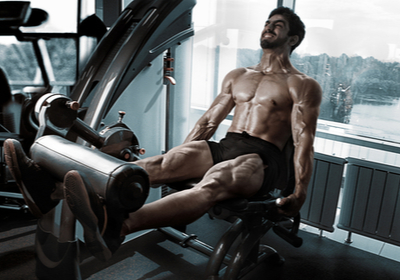VIDEO
Single Leg Squat
- Core
- Legs
- Gluteus
- Hips
- Calves
Level:Advanced
Trainer:Ann Summer
Equipment:No Equipment
Single Leg Squat
- Core
- Legs
- Gluteus
- Hips
- Calves
Level:Advanced
Trainer:Ann Summer
Equipment:No Equipment
Stand on one leg, another leg should be a little bent. Try to squat on one leg without using another one. Don’t be in hurry and take your time.
save to ...
RECOMMENDED FOR YOU
Lunge Jump
- Legs
- Gluteus
- Calves
Duaration: 00:24
save to playlist
Kettlebell Straight Arm Situps
- Core
- Abs
- Biceps
Duaration: 00:36
save to playlist
Bridge, Single Leg Bridge, Crunches, Bicycle
- Legs
- Abs
- Lower Back
Duaration: 00:15
save to playlist
Kettlebell Russian Twist
- Core
- Abs
- Triceps
Duaration: 00:29
save to playlist
lower backExtension
- Core
- Abs
- Upper Back
Duaration: 00:43
save to playlist
Side Plank Hip Dips, Side Plank Leg Lifts
- Core
- Abs
- Triceps
Duaration: 00:14
save to playlist
One Leg Lunges, Pushups, Long Arm Crunches, Reverse Pushups
- Legs
- Abs
- Biceps
Duaration: 00:15
save to playlist
Knee Push Ups
- Core
- Triceps
- Upper Back
Duaration: 00:30
save to playlist
Single Leg Squat
- Core
- Legs
- Gluteus
Duaration: 00:30
save to playlist
Barbell Overhead Squat
- Core
- Biceps
- Upper Back
Duaration: 00:51
save to playlist
Plank Knee to Elbow Variation, Mountain Climbers, Elbow to High Plank, Plank Jumps
- Core
- Arms
- Legs
Duaration: 00:15
save to playlist
Reverse Roll Up With Pushup
- Core
- Abs
- Biceps
Duaration: 00:15
save to playlist
Squat Jumps, Plank Jacks, ToeTouch Jump Squats, Plank Jumps
- Arms
- Legs
- Abs
Duaration: 00:15
save to playlist
Nordic Curls
- Core
- Gluteus
- Hamstrings
Duaration: 00:38
save to playlist
Barbell Glute Bridge
- Core
- Triceps
- Gluteus
Duaration: 00:44
save to playlist
Jumping Jacks
- Core
- Gluteus
- Quads
Duaration: 00:29
save to playlist
Stairs Pushup Variations
- Core
- Arms
- Upper Back
Duaration: 00:15
save to playlist
Shoulder Touches
- Core
- Back
- Triceps
Duaration: 00:30
save to playlist
Lunges, Side Squat, Plank to Squat Jump, Side Plank Variation, Pushups, Side Plank Hip Dips, Double Leg Lifts, Bicycle
- Core
- Arms
- Legs
Duaration: 00:15
save to playlist
Wall Sit
- Gluteus
- Quads
- Hamstrings
Duaration: 00:34
save to playlist
Elbow Plank, Side Plank Variation, Pushups, Crane Pose
- Core
- Arms
- Back
Duaration: 00:15
save to playlist
Running Jacks
- Gluteus
- Quads
- Hamstrings
Duaration: 00:15
save to playlist
Kettlebell Swing
- Core
- Biceps
- Trapezius
Duaration: 00:39
save to playlist
Dumbbell Side Lunge to Press
- Biceps
- Triceps
- Lower Back
Duaration: 00:44
save to playlist
Reverse Lunge to Skip
- Gluteus
- Quads
- Hamstrings
Duaration: 00:48
save to playlist
Pushups Variation, Burpees, Elbow Plank
- Core
- Legs
- Biceps
Duaration: 00:15
save to playlist
Jump Squat Variation, Flutter Kicks, Squats, Alternating Side Lunge
- Biceps
- Trapezius
- Upper Back
Duaration: 00:15
save to playlist
High Knees
- Gluteus
- Hamstrings
- Hips
Duaration: 00:30
save to playlist
Kettlebell Figure 8
- Core
- Triceps
- Shoulders
Duaration: 00:27
save to playlist
Dumbbell Clean To Press
- Abs
- Biceps
- Upper Back
Duaration: 00:46
save to playlist
Jumping Jacks
- Gluteus
- Quads
- Hamstrings
Duaration: 00:30
save to playlist
Stair Running, Scissors
- Core
- Biceps
- Triceps
Duaration: 00:15
save to playlist
Fire Hydrant
- Core
- Shoulders
- Gluteus
Duaration: 00:28
save to playlist
Jump Ready Holds
- Core
- Gluteus
- Quads
Duaration: 00:35
save to playlist
Single Leg Pushup, Crab Walk, Split Squat, Walking Toe-Touches
- Biceps
- Triceps
- Trapezius
Duaration: 00:14
save to playlist
Squat Side Kick, Lunge Hop, Forward Leg Swings, Donkey Kicks
- Core
- Back
- Biceps
Duaration: 00:13
save to playlist
Side Plank
- Core
- Back
- Shoulders
Duaration: 00:30
save to playlist
Barbell Front Squat
- Core
- Abs
- Triceps
Duaration: 00:47
save to playlist
Forward Lunge, Squats, Lunge with Reverse Leg Kicks, Side Crunch, Plank Variation
- Core
- Arms
- Legs
Duaration: 00:15
save to playlist
Half Handstand Variation
- Core
- Arms
- Legs
Duaration: 00:15
save to playlist
Blog
The calf muscles are often neglected in the early training stages when people concentrate on working out the chest, arms, and back. As a result, exercises for building calves are postponed or performed extremely rarely, which leads to a lack of progress. The muscles of the lower legs, as well as the deep muscles of the back, practically do not rest during the day, as they have to bear the weight of the body, help maintain balance, and stabilize the joints when walking. This means that it is focused on a low level of development and the way of working with it should be different.Here are some exercises for calves.
Calves 45Among all the exercises this one is aimed at developing the calf muscles, it is also one of the most difficult ones. It's all about changing the angle of the legs, which allows you to use not only the calves but also the soleus. To perform this exercise, you need Gakkenshmidt's Machine. Depending on the design, you will be facing it or not. Set a suitable operating weight. It is calculated as the arithmetic average between the working weights in the two previous exercises. Next, select the weights according to the loads. Then you need to lower the heels, trying to stretch the calf as much as possible. Perform a toe lift. Lock in the position of extreme tension for 1-2 seconds.
Calf raises with dumbbellsThis exercise is designed for athletes of any level and is considered the main one for working out the calf muscles. Stand on a wooden block. You can perform a movement in Smith, getting a step platform under your feet, and put the barbell on your shoulders. Fix the body in a straight position. If additional weight is required, dumbbells or weights should be taken. Next, you need to lower your heels below the level of the bar, trying to stretch the ankle as much as possible. Rise on your toes with a powerful impulse movement. Stay in this position for 1-2 seconds and tighten the calves. Slowly lower and get back to the starting position.
Seated calf raisesThis exercise is great for lazy training and will be a perfect option for beginners. Sit on the machine seat. Place the toes of the feet on the support step. Lower your heels to the floor as much as possible. Lower the lever with soft stops on your knees and lock.
Leg pressLie on a leg press machine. This uncommonly effective device for working out the legs can be used for training the calf muscles. Look for the platform where the legs would be straight. Fix the speed. You only need to do two actions. Remove the platform from the stops and squeeze it out with your toes. Return the socks to their original position.
It is important to know that the effect of posture on the development of the lower leg and calf muscles is much stronger than the effect of training. Flat feet, if not taken into account and not compensated, also interfere with bringing the shape of the lower leg. To improve your calves without exercising machines, you can simply choose the right shoes and adjust your gait.
Wrapping Up
Developed calves not only help you perform certain exercises better but also make your legs look simply gorgeous. Therefore, take another look at these exercises and make sure to at least give them a try while working out next time.
Read more
The oblique muscles are several groups of abdominal muscles located on the sides of the core. The external oblique muscle lies on top and the internal oblique is underneath. Functional exercises for their training are inclinations, turns to the sides, and other rotating movements. However, in order to properly build lateral muscles, you need to remember that most oblique exercises involve the other abdominal muscles, in particular, the internal transverse muscles. That is why it is necessary to be able to consciously involve certain areas of abs.
Best Exercises for Obliques
1. Side crunchesThe basic exercise for the oblique muscles of the abdomen is the lateral twisting of the lying. Starting position: lying on your side, an arm bent at the elbow supports the head. Slowly stretch your elbow towards your legs, making a movement to deliberate contraction of the oblique abdominal muscles.
2. Side crunches on the backThis exercise is useful for developing the neuromuscular connection between the abdominal muscles and the brain. Lying on your back, slowly stretch your left elbow towards your right knee. Do 12-15 repetitions for each side, trying to achieve a particular burning sensation.
3. Side crunches on the fitballThe benefit of this exercise lies in the wide range of motion achieved by slowly and controlled bending of the body on the ball. While lifting, feel the twisting of the side press, while lowering, feel the stretch. Keep your hands behind your neck and do not spread them apart.
4. Cross contactsFirst, lie on your back with both legs extended upward. Your hands should be placed on the back of the head, slightly raise your head and shoulder blades. After that, do the twist, reaching the leg with a straight opposite hand. Repeat the same steps for the other side. Do at least twenty repetitions.
5. Hips liftingLie on one side and make sure that you are lying straight. Your legs should lie on top of each other and your free hand is fixed on the belt. Your task is to raise the body so that at the peak amplitude the body line is fully straightened. At the top point, a small pause is made to emphasize the work of the oblique muscles. When lowering the torso, the thighs only lightly touch the floor, the muscles do not relax completely.
Final Word
Developed oblique muscles frame your abs and make them look simply stunning, so if you really want to have a gorgeous abdomen, you have to work on both your abs and obliques.
Read more
Chest muscles are among the hardest ones to train yet strengthening these muscles is totally possible. In this article, we are going to talk about chest muscles and how to train them.
How to Develop Chest Muscles
Developed chest muscles are a vivid indicator of hard work on the body. This muscle group is one of the largest and most complex in the human body. Complete training demands to combine basic and isolating exercises. This is the only way to build the muscles in perfect shape. Barbell exercises are more suitable for increasing muscle mass, and with dumbbells and equipment - for improving the shape and detailed work. It is a bad idea to use really heavyweights in the beginning. It’s much better to learn how to feel the work of the necessary muscles during working out your chest, your arms and shoulders. For example, classic push-ups from the floor will help you feel your chest muscles and understand how they work. For a proper workout, you need to use a variety of dumbbell chest exercises to work the muscles at different angles.
Workouts for Chest
Dumbbell bench pressPlace the dumbbells near your hands. Start by taking the correct position. The back of the head, back and pelvis are pressed to the bench. The heels are pressed into the floor, the legs are separated by 60 degrees. Memorize the position, sit down, grab the dumbbells, and put them on your knees. Lie down while getting the dumbbells to your chest. Extend your arms, leaving a slight angle at the elbow joint, keeping the dumbbells in parallel. Start the chest exercise with a smooth lowering of the weight, moving your elbows to the up and down. When you feel a stretch in your pectoral muscles, return your arms to their original position.
HammerStart it with the right position. Sit on the edge of a bench with the dumbbells on your knees. Lie down tightly pressing the back of your head, back, and lower back to the bench. At the same time, shift your weight from your hips to your chest. Raise your arms in front of you, keeping a 90-degree angle. The palms are turned towards each other, the elbows are slightly bent. Bend your arms as you inhale, bringing the dumbbells to your chest. During the exhalation, unbend focusing on the tension of the pectoral muscles. Repeat it. The Hammer adds extra tension to the triceps, so it's important to focus on your chest muscles. The exercise must be done slowly, and it requires concentrated work. It is great for beginners and athletes recovering from chest, shoulder, or elbow injuries.
Dumbbell PulloverLying on a bench, the back of the head, shoulders and buttocks are kept to the surface, the feet stand firmly on the floor, the hands hold the dumbbells on the chest line with one hand on the other. Fix it and raise the dumbbell over your head, doing a slight bend of the elbow. Exhaling, gently lower the dumbbell behind your head, focusing on stretching the pectoral muscles. Only the shoulders work in the process. Having reached the maximum tension in the lower amplitude, return your arms back along the same trajectory. This exercise with dumbbells on the chest is optional, therefore it is more logical to use it in the mix with basic exercises. It helps to stretch the chest muscles, as well as increase the shape of the chest. Make sure that the head is supported in this position. Otherwise, the risk of straining the cervical muscles or pinching the nerve becomes critical. Work the dumbbell smoothly, avoiding sudden jerks and extreme weights.Also don’t forget that some pre-workout warm-ups are great for increasing your stamina and recovery, but don't rely on them all the time. Getting the right amount of sleep and proper nutrition are two of the most important factors in increasing your gym performance.
Final Thoughts
Exercises for your chest will help you improve your relief as well as general health, so make sure to train these muscles at least a little bit while working out.
Read more
Of course, everyone who is familiar with running knows the importance of strengthening the ligaments of the foot and ankles. Another thing is that sometimes it is hard to spend 5-10 minutes on training for ankle exercises: we dress, tie our laces - and run out into the street. That’s sad. After all, the good condition of the elastic ligaments reduces the risk of pain in the feet. And strong ankle muscles improve the power of the lower back and even the shoulders while running and just walking.
Best Exercises for Strengthening Your Ankles
Of course, there are plenty of good exercises that will help you work out your ankles, so without any further ado, let us have a look at those.
Stretching towardsSit on the floor and straighten your legs in front of you. It is important to ensure that your thumb, little toe, and heel remain in the same direction as you pull the foot over. Only under this condition the muscles will be strengthened and stretched in a balanced way, which will prevent collapse on the outer or inner part of the foot while walking and running. When pulling the foot away from you, try to stretch your toes, as if you are making them longer and do not twist them under the foot. Repeat 15 times.
RollingFrom a seated position with your feet in front of you, pull your feet as close to you as possible. Put your knees sideways, keeping your feet together. Keeping this position of the legs and resting with your hands on the floor, lean your body forward and raise your pelvis above the floor, trying to stay in position for a while. If you feel the potential in yourself, you can roll left and right, touching your feet with your palms.
Ups and downs exerciseTraditionally, they are offered to be done on stairs, but slow doing on a flat surface will give an excellent result. Rise on your toes as high as possible, keep your heels in weight, and then bend your knees, pushing your heels forward. Place your heels on the floor, and only then straighten your legs. It is very important to make sure that your knees and ankles do not roll or fall.
Dumbbell squatsSquats are good for developing your ankles and combined with dumbbells or a barbell (if you're already trained enough), this exercise becomes even more effective. Start with those dumbbells that you can lift 15 times without having to put them on the floor. For beginners, a weight of 2-3 kg is suitable. Bodybuilders need to lift more weight to build leg muscles. Perform squats as follows: stand straight, feet shoulder-width apart, arms with dumbbells at your sides and if you are doing an exercise with a barbell, hold it on your chest or behind your head. Sit down, bending your knees and lowering your buttocks to the floor. Keep your back straight and squat until your thighs are parallel to the floor. The knees should always remain directly over the feet; do not push your knees further than your toes. Push yourself back to the starting position. Do 2 sets of 10-15 squats.
LungesKeep your torso straight and your shoulders back. Step forward and lower yourself until both your knees are at the 90-degree angle. Make sure that your knees do not protrude over your toes. Do two sets of 10 repetitions for each leg.
Final Word
Strengthening ankles is extremely important for both professional athletes and sports enthusiasts, so no matter if sport is your life or you work out just to keep in shape, you still need to work on your ankles.
Read more
The quadriceps is a large and strong muscle that plays the role of the main extensor of the knee joint. Since the knee joint carries the bulk of body weight, the quadriceps is the main muscle of the lower part of the thigh. In fact, if this muscle was weak, people simply would not be able to keep an upright posture. The quadriceps muscle consists of the following parts: straight, internal, external, and middle. Despite this, the load during a variety of exercises falls entirely on this muscle.
Workouts for Quads
Of course, it is very important to strengthen your quadriceps, so let us take a brief look at some of the best exercises for these muscles.
Barbell and dumbbell lungesLunges can be done in different ways - with a barbell, dumbbells, walking around the hall, or from a standing position. Consider options in which the athlete stands in one place, using either a barbell or dumbbells. It is similar to the position when squatting with a barbell on the back. Step forward with your right foot. The lunge should be such that the thigh of the working leg at the lowest point is parallel to the floor. At the same time, the knee of the left leg almost touches the floor and also forms a right angle. Return to the previous position. Swap legs - lunge with your left leg forward.
Leg pressThe leg press eliminates the work of the back and buttocks as much as possible. At the same time, the simulator makes it possible to work with a much higher weight than in squats. In order for the load to fall on the quadriceps, you need to press when setting your feet shoulder-width apart. The execution technique is the following: the back and head are tightly pressed against the back of the simulator, the legs are almost completely straightened and rest against the frame, the hands firmly hold the handles. Bend your knees to form a right angle between your hips and lower legs. Return the legs to the previous position.
One leg squatsCan't go to the gym? Squat on one leg. This is a great exercise for the quadriceps, with which you can load your legs without using additional weights. Start in a standing position, slightly extend one leg forward. Squat down, extending the leg forward and straightening it. Return to the previous position. Do at least 10 repetitions for each leg.
Kick SquatStand with your feet shoulder-width apart and your toes slightly turned to the sides. Place your hands on your belt or hold them near your chest. The emphasis should be on the middle of the foot. Sit down in a horizontal position of your hips, do not forget to keep your back straight. Stand up and shift your weight to one side. Raise your knee to a horizontal position and kick. The kick should go in one motion.
Fitball squatsPlace your feet slightly wider than your shoulders, turn your toes to the sides at 45 degrees. Take the fitball, keep tension and natural deflection in your lower back, your shoulders should be straight as well as your neck. Take a fitball and raise your arms to shoulder level. Along with inhaling, start to bend your knees to the sides, making sure they do not protrude over your toes. At the same time, your buttocks should go down first. The center of gravity lies on your heels. While squatting down, slightly get your back forward, with outstretched arms and raise the fitball above your head. Do 30-50 repetitions.
Final Thoughts
Everyone dreams of beautiful legs and, luckily, getting gorgeous quads is not that difficult at all if you know what you are doing. So why don’t you give these exercises a try?
Read more
SAVE TO ...





